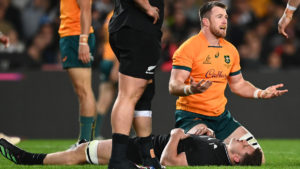Broadly speaking, the pandemic was neutral or beneficial for the ASX-listed life sciences sector – but not so for Medical Developments (ASX:MVP) and its famous ‘green whistle’ painkiller.
Reduced ambulance call-outs in locked-down geographies and the cancellation of mass participation sports meant soft demand for the green whistles, which contain the inhaled analgesic methoxyflurane (Penthrox).
Medical Developments holds worldwide rights to the 46-year-old painkiller and is its only manufacturer.
The company also produces respiratory devices such as asthma spacers, but ironically was one of the few respiratory companies to be affected negatively by Covid-19.
As management laments, sales were depressed because of fewer cold and ’flu cases and “improved hygienic practices” – which doesn’t sound too bad for the rest of us.
The poor conditions led to the company reporting its first loss in seven years and demotion from the ASX300 index.
The company also parted ways with its European and Australian distributor Mundipharma, which is owned by the litigation-mired US opioid drug maker Purdue Pharma.
“While there were some accomplishments during the period, for the most part we were left to pick up the pieces and move forward in a new direction,” chief executive Brent MacGregor told the company’s virtual AGM.
Whistle through the pain
Medical Developments is all about re-inventing Penthrox, which was first used here in 1975.
Penthrox is also used as a veterinary drug, having been approved a decade ago in the US under the brand name Anafane.
Declaring ‘It’s Time’ for a fast-acting, non-addictive painkiller, prominent anaesthetist Dr David Komesaroff founded Medical Developments in 1972.
Penthrox was (and is) pitched as a rival product to nitrous oxide (laughing gas), morphine, Fentanyl (an opioid) and ketamine (better known as a horse tranquilliser).
Steered by then chairman and biggest shareholder David Williams, Medical Developments listed on the ASX in December 2003, after raising $8.7 million at 25 cents apiece.
So far, more than seven million patients have administered Penthrox safely and effectively in multiple geographies.
In March 2020, CEO John Sharman departed, with board member Max Johnson acting as interim head before MacGregor assumed command in November 2020.
MacGregor was the head of commercial operations at Seqirus (CSL’s old influenza division) and formerly headed Novartis’ ’flu arm.
The former chief financial officer for CSL and then head of Seqirus, Naylor joined the Medical Developments board in October 2020 and a month later assumed the chairmanship from Williams.
Naturally, Naylor approached his old colleague MacGregor, who was in the throes of leaving Seqirus.
“Frankly, I did it as a courtesy to Gordon when he first reached out to me, but one thing led to another,” says MacGregor, who is Canadian-born but a US citizen domiciled in New Jersey.
Shaking the joint up
MacGregor wasted no time orchestrating a business improvement program to sharpen the company’s commercial direction and instill a culture of setting and meeting targets.
(Ironically, his predecessor Sharman did the same at his next gig as head of Universal Biosensors.)
MacGregor notes that 80 per pent of the Melbourne head office team is new, with global markets experience.
“We weren’t resting on our laurels, but expected bigger results which in hindsight were never going to be achieved,” he says.
A key message was just because Penthrox is registered in a country, it doesn’t mean the company will – or should – sell there.
Examples are Lithuania, Estonia, Latvia, Macedonia and Montenegro.
“We have actually relinquished market authorisations since I came on board,” he says.
“For our regulatory people it’s a dagger in the heart and I feel for them. But there’s a cost to maintaining a regulatory file.
“For example, if a testing lab changes address, you need to update that [with regulators]. It’s minutiae but there’s a cost associated with it.”
He adds that he is not criticising his predecessors, who operated in different circumstances.
Revamping distribution
In 2020, Medical Developments re-acquired the European Penthrox rights from Mundipharma, as well as the Australian franchise. At the time, management described the parting of ways as “collegial and friendly”.
Medical Developments now distributes directly in France, Belgium, the Netherlands, Germany, Italy and Spain.
“In hindsight, Mundi were masters of opioids so they had their own products,” MacGregor says, adding the sales reps weren’t going to “speak out of both sides of their mouths” by selling Penthrox as well.
“The elephant in the room is they’re going through the biggest litigation in the history of pharma, and they were preoccupied, to say the very least.”
In Canada, Medical Developments has also re-claimed the rights from Purdue Pharma.
The Northern Ireland-based Galen Pharmaceuticals continues to distribute in the UK and Ireland and won management plaudits by boosting sales by 41 per cent last year. Supply deals with St Johns Ambulance and Scottish Ambulance have been extended for five years.
Another distributor, Medis, has been engaged in five central European countries: the Czech Republic, Slovenia, Slovakia, Austria and Croatia.
In 2017, Tokyo’s Daiichi Sankyo was hired to cover China, Thailand and Vietnam.
What about the US?
The big gap in Medical Development’s global repertoire is the US, where the US Food and Drug Administration remains to be convinced.
There’s a bit of history here, in that methoxyflurane was used as an anaesthetic in the US, but not an especially good one and the agency withdrew approval.
MacGregor argues the anaesthetic product of 25 years ago had 20 times the dosage than Penthrox’s current usage, with a different patient population.
“But methoxyflurane is methoxyflurane and these folk [at the FDA] stay in their seats for a very long time,” he says.
In any event, last August, the agency put a ‘clinical hold’ on the company, over kidney and liver toxicity concerns. This means it can’t yet sally forth with a proposed Phase III trial in view of gaining approval.
The company expected to lodge a full clinical hold response by the end of December 2021. But at the time of publication, we weren’t able to confirm that had happened. The agency then has 30 days to respond, which implies there should be some news soon.
Take a deep breath
Medical Developments also has a significant respiratory device business, with products such as Space Chamber and the Breath-A-Tech asthma device (acquired for $2.5 million in 2016 from Avita Medical).
Breath-A-Tech products are stocked in 20,000 US pharmacies, while the company makes spacers for Walmart on a private label basis.
A collapsible breather is being stocked here by the Chemist Warehouse chain.
The company also has front-line oxygen therapy and resuscitation devices with names such as Oxi-Port and Oxi-Sok (therapy) and Oxi-Pro and Oxi-Life (resuscitation).
In cahoots with the esteemed Commonwealth Scientific and Industrial Research Organisation, the company is working on a manufacturing method based on its continuous flow platform.
Without knowing too much more, we can report the technique results in lower costs with a smaller carbon footprint than traditional batch processing.
The company is also working on the Selfie: a next generation, self-administered inhaler for pain relief.
Finances and performance
“We won’t be profitable this year because we are investing a lot in the business,” MacGregor says. “We hope to be sustainably profitable by 2023 but we are not giving guidance.”
The $12.56 million bottom-line loss for the year to June 2021 was not as bad as it seemed, in that it resulted in two non-cash write downs. These pertained to the carrying value of the respiratory division ($4.7 million) and capitalised costs of the CSIRO project ($3.14 million).
The latter move recognises the company is unlikely to derive revenue from these efforts in the foreseeable future.
The board refrained from declaring a dividend, having dispatched two cents a share in 2019-’20 and four cents a share in each of the previous four years.
Full-year revenue declined 12 per cent to $25.2 million. A key factor was the phasing-out of the Mundipharma tie-up, which created a supply gap as the distributor sold down its inventories.
The results show that Penthrox accounted for 77 per cent of revenue, or $19.5 million, with the devices accounting for the remainder except for $380,000 from the veterinary device arm.
The geographic split shows a 33 per cent bias to Australia, with the rest of the world accounting for the remaining two-thirds. In the previous year, the split was more like 50:50.
The company is flush with funds, having raised $36.7 million in December 2020 – $24.9 million via a placement and $11.8 million with a share purchase plan.
Over the last 12 months Medical Developments shares have traded between $7.18 (January 21, 2021) and $3.35 (September 6, 2021).
The stock peaked at $11 on February 20, 2020, just before the spectacular but brief Great Covid Market Meltdown.
Despite the market gyrations, Medical Developments shares are pretty much where they were one year ago and five years ago.
What’s next?
Medical Developments can continue to make inroads into the ambulance and sports markets, which is the headline-grabbing stuff.
But more fertile growth lies with expanding the use of Penthrox to emergency departments and minor surgeries.
MacGregor says doctors have told him the drug is already being used off-label in these settings.
Medical Developments is also eyeing expanded uses for Penthrox, including as an item in home first-aid kits, for military purposes and for developing world aid programs.
In the short term at least, the respiratory side is expected to continue to account for about one-third of revenue.
“The US space chamber market is enormous but we have a very tiny share,” MacGregor says. “A lot is commoditised but we should be able to gain a better share than we have.”
Dr Boreham’s diagnosis:
When we last covered Medical Developments in June 2019, we pondered whether MVP could become the ASX-listed biotech sector’s GOAT.
(For sports aficionados, this was a witty play on the company’s share code MVP – most Valuable Player and Greatest of All Times.)
Given MVP’s recent slip-ups, we’re a bit sheepish about the GOAT prediction. Still, there’s no reason the company can’t vie for Biotech Hall of Fame status.
Like a football player overcoming a dodgy knee, Medical Developments’ comeback is gaining pace.
“Encouragingly, when restrictions eased in the [current half year] the company experienced a strong rebound in local Penthrox sales, with similar trends also observed in international Penthrox markets,” Naylor told shareholders.
As has been the case for some years, gaining US approval remains the key to stepping to the next level.
Disclosure: Dr Boreham is not a qualified medical practitioner and does not possess a doctorate of any sort. He is not the greatest of all time but is regularly called a goat anyway.
This column first appeared in Biotech Daily
You might be interested in











